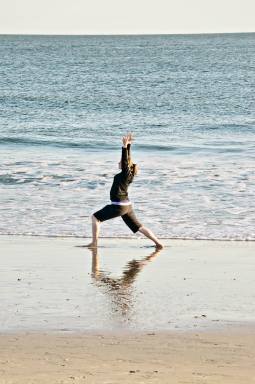Since we’re talking about yoga and sex this month, I’ll be bringing you a few fun poses you can do with a partner!
Pose Name: Double or Partner-Assisted Boat Pose
Sanskrit Name: Navasana
Steps:
- Sit facing your partner with your knees bent. Reach out and clasp your partner’s hands or wrists (clasping hands will give you a little more room to work with your legs, but clasping wrists gives a little more stability).
- Lift your right foot off the ground while your partner lifts her left foot off the ground. Press the soles of your foot against the sole of your partner’s foot. (It will help if you’re able to keep your right knee inside your arms.) Begin to straighten the right knee.
- Repeat on the other side, lifting your left foot and pressing it against your partner’s right foot.
- Once both feet are up, you can work on straightening the legs. Make sure to use your core muscles to hold you up as you would in regular boat pose.
- Work playfully with the pose, have fun, and don’t forget to breathe.
- Come down slowly, one foot at a time, and release your hands.
Benefits:
Boat pose really strengthens the core muscles and stimulates the abdominal organs. In terms of our ongoing yoga and sex series, boat pose is great because it warms up the core and gets your energy flowing!
Practicing boat pose with a partner can give you added stability and support to straighten the legs while you work the core. Plus it’s fun!
Contraindications:
Contraindications for boat pose include asthma, insomnia, diarrhea, heart problems, low blood pressure, and pregnancy. Those with neck problems may want to practice boat pose at the wall (so you can lean your head back and rest it against the wall).
This isn’t a contraindication, but if you’re practicing double boat with a partner, it will be trickier to do if the two of you have different leg lengths (i.e., someone short practicing with someone very tall). See the photo below: my legs are longer than Stacey’s, so my knees are slightly bent. However, I can still move much further into the pose with a partner than I can on my own! If you and your partner are differently proportioned, try the pose anyway and just have fun with it. Be ready to laugh!
My Experience with Boat Pose:
Long have I hated boat pose. It’s one of those poses where I just never seem to improve. My core isn’t strong enough, it’s hard to straighten the legs, and even my arms get sore. So I was excited to find this fun modification of boat that can be practiced with a friend. You still get a core workout, but without all the disappointment. Instead, it’s a great way to share yoga with your partner and get warmed up together!
Thanks to Stacey for helping me model this pose!



